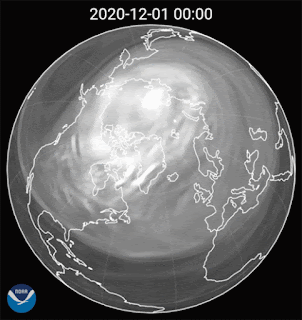Wake Vortex

I was poking around in some websites that provide public domain photographs, and found this beauty on the NASA Image Exchange.
This was part of a Wake Vortex Study done by NASA in 1990 at Wallops Island. (Wallops Island?). The air flow from the wing of the plane is made by a technique that uses colored smoke rising from the ground. The swirl at the wingtip traces the aircraft's wake vortex, which exerts a "powerful influence" on the flow field behind the plane. For that reason, the FAA requires aircraft to keep some distance between each other when they land.
NASA and the FAA conducted the Wake Vortex Study to find out how close planes could land together, with the aim of boosting airport capacity. That was 19 years ago. I did a little research and found that they're still trying to find ways to get more accurate data on wake vortices. They do have some sort of Lidar system that works pretty well, but is sensitive to rain and fog. A conference paper from 2008 says: "knowledge about the safety issues caused by wake vortices has to be improved."
This falls under the category of Things I'm Better Off Not Knowing About. I've grown increasingly reluctant about flying in recent years, and don't really want to imagine all the air currents that are swirling about the wing tips of my airplane. I'm an asphalt hugger of the first order. Give me an open road and a jalopy. I've realized that I'm probably never going to be a world traveler, and God forbid I should get famous and have to go on tour. (Must try to make sure that doesn't happen.) As much as I love clouds, and consider myself somewhat an ethereal being, I prefer the dear, firm earth to hurtling through the sky.










Cool photo! The red dust reminds me of the Wicked Witch of the West. Nice informative writing.
ReplyDeleteso i guess that the "blue angels",,navy's ace flying/performance team,,must just laugh at stuff like a wake vortex. because they fly like,,really really close together! (and that is a technical term, dearies.)
ReplyDeleteWell, I think the wake vortex is mostly a concern at take-offs and landings. Any idea, Marc? But you're right --there must be so many risks involved in flying planes that close together, wake vortex or not.
ReplyDeleteThe wake vortices you have to worry about are caused by big planes, like airliners. They're not caused by fighters. The reason the blue angels don't worry about wake vortices is because there aren't any airliners taking off while they're performing. Of course, flying planes that close together at hundreds of miles per hour is insanely dangerous. One little slip can wipe out the whole squadron, and could also kill a lot of spectators if it happened close to the ground.
ReplyDeleteWake vortices are most dangerous to small planes and commuter planes taking off or landing after an airliner has taken off. They're not as dangerous to airliners.
wow! marc,,thanks for that information. now that makes me wonder---could it be possible that the plane that crashed a couple of weeks ago been affected by one of those wake vortices? hmmmm. something to think about. it was a turbo-prop, after all. and it was preparing to land.
ReplyDelete